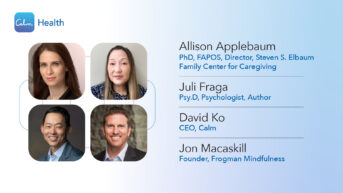Clinically reviewed by Chris Mosunic, PhD, RD, MBA, Chief Clinical Officer, Calm
In many ways, we’ve never been more connected. Zoom calls put remote employees in the same virtual room throughout the workday. Social media platforms enable people from all corners of the world to interact at will. Instant messaging technology bombards us with requests and updates from friends, family, colleagues, clients, and others on a near constant basis.
Yet, for all this technology-enabled connection, many of us are feeling a great loss: a lack of true emotional connection with fellow human beings. According to Cigna’s Loneliness in America 2025 report, more than half of US workers (~52%) are feeling chronic loneliness—i.e., they’re feeling isolated, left out, or lacking in companionship on an ongoing basis.
What can we do about it to feel more connected? In honor of World Mental Health Day, Calm brought together a panel of mental health experts to address the loneliness epidemic. Moderated by Calm Chief of Staff Bennett Porter, In It Together: Tackling Loneliness and Creating a Connection featured psychologists Dr. Allison Applebaum and Dr. Juli Fraga, retired Navy SEAL commander turned mindfulness coach Jon Macaskill, and Calm CEO David Ko.
Here are three takeaways from their discussion.
1. Loneliness can affect anyone, anywhere. Feeling misunderstood or unseen is a common thread.
Loneliness isn’t just about being alone—it can touch anyone, in any setting, and it often “hides in plain sight,” said Macaskill. “It’s often the high performer who’s burning out quietly. It’s the leader who feels like they have to have all the answers, or it’s the veteran that can’t quite find their footing after leaving the service.”
Loneliness can creep up on the mental healthcare professional who carries the weight of patient stories confidentially, Fraga explained, or the ultra-busy parent who feels they have no one to really talk to. It can take a heavy toll on the family caregiver who feels isolated and trapped by the demands of caregiving that they’re managing on top of a full-time job, echoed Applebaum.
Indeed, loneliness takes many forms, but one common thread is the feeling of being misunderstood or unseen—”feeling like there just isn’t somebody who really understands our experience, especially if we’re individuals who are part of communities where we feel marginalized in any way,” said Fraga.
“And when we don’t feel known or seen, we start to disengage,” Macaskill noted. In fact, employees who struggle with loneliness are five times more likely to show absenteeism from work due to stress, said Ko, and twice as likely to want to quit than employees who don’t. When employers invest time in recruiting and training staff but fail to ensure those employees feel heard and connected, it’s a big miss, he added.
2. Taking small steps can alleviate feelings of loneliness and build connection
Just as loneliness shows up differently for different people, there’s no universal approach to easing it. What matters most is taking action, the panelists underscored. Even when loneliness might be holding us back, taking small behavioral steps can help us feel better, explained Dr. Fraga, author of the Calm Health program on loneliness.
“It might be even taking that step to leave the house, go sit in the park, go sit in a cafe, or strike up a conversation with a stranger, even if it’s just a hello or a compliment,” Fraga said. “We know from research that even pro-social behavior and altruism generate positive feelings both for the person who’s giving the compliment as well as the person who’s receiving it. And that can be a great way to reduce feelings of loneliness, and it’s a really tiny thing that we can all do.”
To alleviate their feelings of isolation, caregivers can speak up about their caregiving status to make sure their colleagues and supervisors are aware of what they’re managing, Dr. Applebaum recommended. “That can be very powerful, not just in lifting the veil on caregiving, but normalizing caregiving and creating community,” she said. When caregivers speak openly about their responsibilities, they invite others to connect, share support, and ease the loneliness that often comes with the role.
Ko emphasized the importance of small gestures in easing employee loneliness. “I think people think we have to do these grandiose-type gestures, but sometimes it just may be the little act of reaching out, striking up a conversation, even just saying hi. And this is where you can use technology at times.“
He suggested holding time at the beginning or end of virtual meetings for casual interactions that happen spontaneously when people are in the same physical space but often get lost when connecting online. “Don’t let everyone just cut the Zoom and leave. Try to foster a little bit of that group dynamic so that people are lingering.”
3. Mindfulness can reduce loneliness
Mindfulness might seem more akin to loneliness than connection. After all, mindfulness often evokes images of a person retreating into solitude to quietly meditate, tuned inward to focus on the present moment.
“But at its core, mindfulness is about connection,” explained Macaskill, ”connection to others, connection to the present moment, and connection to yourself.”
When we’re disconnected from ourselves and others, loneliness can set in. “It’s about being disconnected from your emotions, your body, your surroundings . . .and when you’re in that state, it’s nearly impossible to connect meaningfully with yourself or anyone else, even the people you love,” he said.
By contrast, when we’re intentional about mindfulness, we give ourselves the space to show up fully for others. “You start to listen differently. You’re not waiting for your turn to talk. . .and that kind of presence instantly communicates safety and care and belonging. It kind of says, ‘you matter. I’m here. I see you.’” This simple practice, Macaskill said, may not eliminate loneliness but helps reduce it.
To promote mindfulness, he also recommends breathing consciously—just three conscious breaths before responding or walking into a meeting can ground your nervous system and move you from a reactive state to a connective state.
“And when we’re grounded, we can see others more clearly. We can empathize, we can be patient, and we can connect,” said Macaskill. “And that’s to me how mindfulness reduces loneliness. It doesn’t change your external circumstances overnight, but it changes the quality of how you relate to those circumstances.
“Ultimately, mindfulness gives us the ability to be with what’s real, our own discomfort, someone else’s pain or even quiet moments in between. And that’s where connection grows, in the space between distraction and presence.”
Watch the full webinar here.




